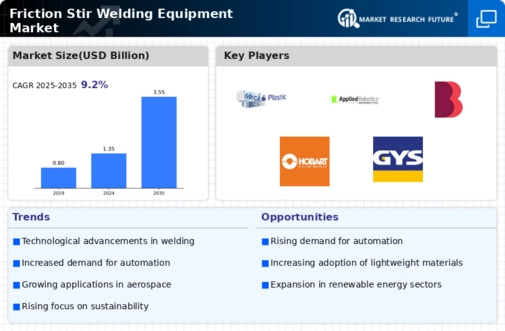Market Growth Projections
Increasing Demand for Lightweight Materials
The Global Friction Stir Welding Equipment Market Industry experiences a notable surge in demand for lightweight materials, particularly in the aerospace and automotive sectors. As manufacturers strive to enhance fuel efficiency and reduce emissions, the adoption of aluminum and magnesium alloys becomes prevalent. This shift necessitates advanced welding techniques, such as friction stir welding, which offers superior mechanical properties and reduced thermal distortion. Consequently, the market is projected to grow from 1.35 USD Billion in 2024 to 3.55 USD Billion by 2035, reflecting a robust CAGR of 9.18% from 2025 to 2035. This trend underscores the importance of friction stir welding in meeting industry standards for lightweight construction.
Rising Investment in Research and Development
Investment in research and development significantly impacts the Global Friction Stir Welding Equipment Market Industry. Companies are increasingly allocating resources to innovate and enhance friction stir welding technologies, aiming to improve efficiency and expand the range of materials that can be welded. This focus on R&D not only fosters the development of new equipment but also leads to the creation of specialized applications across various industries, including automotive, aerospace, and shipbuilding. As a result, the market is likely to experience sustained growth, driven by the continuous evolution of welding technologies and their applications.
Growing Applications in Renewable Energy Sector
The Global Friction Stir Welding Equipment Market Industry is increasingly influenced by the expanding applications within the renewable energy sector. As the world shifts towards sustainable energy solutions, friction stir welding is being utilized in the fabrication of components for wind turbines and solar panels. The ability to join dissimilar materials effectively makes this welding technique particularly valuable in these applications. Furthermore, the push for energy-efficient technologies aligns with the market's growth trajectory, as investments in renewable energy infrastructure continue to rise. This trend indicates a promising future for friction stir welding equipment as a critical enabler of green technologies.
Technological Advancements in Welding Equipment
Technological innovations play a pivotal role in shaping the Global Friction Stir Welding Equipment Market Industry. Recent advancements in automation and robotics enhance the precision and efficiency of friction stir welding processes. For instance, the integration of artificial intelligence and machine learning algorithms allows for real-time monitoring and quality control, thereby minimizing defects and optimizing production cycles. These developments not only improve operational efficiency but also reduce labor costs, making friction stir welding an attractive option for manufacturers. As a result, the market is expected to witness significant growth, driven by the increasing adoption of these advanced technologies.
Regulatory Support for Advanced Manufacturing Techniques
Regulatory frameworks increasingly favor advanced manufacturing techniques, thereby influencing the Global Friction Stir Welding Equipment Market Industry. Governments worldwide are promoting the adoption of innovative welding technologies to enhance manufacturing efficiency and competitiveness. Initiatives aimed at reducing carbon footprints and improving safety standards further encourage industries to adopt friction stir welding. This regulatory support not only facilitates market growth but also aligns with global sustainability goals. As industries comply with these regulations, the demand for friction stir welding equipment is expected to rise, contributing to the overall expansion of the market.







